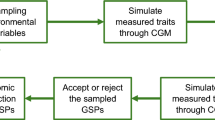Summary
Quantitative genetic theory for autogamous crops enables the estimation of the parameters m (F∞-mean) and D (F∞-variance) in the F3-generation. With these estimated m and D a prediction can be made of the probability of finding superior inbred lines in the F∞-offspring of the cross. The accuracy of this procedure is influenced by the correctness of the genetic model, by the magnitude of the error variance, and by the bias caused by intergenotypic competition, which is present in the environment in which the F3 is grown and absent in the monoculture environment at which the selection is aimed, especially in a cereal crop like wheat. The influence of the intergenotypic competition was investigated by a special method of simulating segregating populations. In this method genotypes in the offspring of a cross are represented by varieties and segregating populations are composed by mixing the appropriate varieties according to the proper segregation frequencies. Growing the simulated population enables the estimation of m and D in the normal selection environment, while simultaneously growing the varieties in a large monoculture trial enables the calculation of ‘true’ values of m and D in the monoculture environment. Hence, a comparison is possible.
The first of this set of two papers presents the investigations on the influence of intergenotypic competition on the estimation of the parameter m. The correlation coefficient of the estimates from the selection environment with the calculated ‘true’ values from the monoculture environment was small. Sometimes the selection environment estimation significantly underestimated the (true) monoculture value of m, sometimes it significantly overestimated the monoculture value. On the average the smaller true values of m were underestimated and the larger ones overestimated.
Similar content being viewed by others
References
Comstock, R.E. & H.F. Robinson, 1952. Estimation of average dominance of genes. In: J.W. Gowen (Ed), Heterosis. Iowa State College Press, Ames, Iowa, pp. 494–516.
Estramil, E. & J. van Balen, 1983. De invloed van intergenotypische concurrentie op selectie voor opbrengst en lengte bij granen. Internal Research Report, Dept. Plant Breeding, Wageningen, 63 pp.
Jinks, J.L. & J.M. Perkins, 1970. A general method for the detection of additive, dominance and epistatic components of variation. III. F2 and backcross populations. Heredity 25: 419–429.
Jinks, J.L. & H.S. Pooni, 1980. Comparing predictions of mean performance and environmental sensitivity of recombinant inbred lines based upon F3 and triple test cross families. Heredity 45: 305–312.
Kramer, Th., J.W.van Ooijen & C.J.T. Spitters, 1982. Selection for yield in small plots of spring wheat. Euphytica 31: 549–564.
Kearsey, M.J. & J.L. Jinks, 1968. A general method of detecting additive, dominance and epistatic variation for metrical traits. I. Theory. Heredity 23: 403–409.
Mather, K. & J.L. Jinks, 1971. Biometrical genetics, 2nd edn. Chapman and Hall, London, 382 pp.
Mather, K. & J.L. Jinks, 1977. Introduction to biometrical genetics. Chapman and Hall, London, 231 pp.
Spitters, C.J.T., 1979. Competition and its consequences for selection in barley breeding. Pudoc, Wageningen. Agric. Res. Rep. (Versl. landbouwk. Onderz.) 893, 268 pp.
Spitters, C.J.T., 1984. Effects of intergenotypic competition on selection. In: W. Lange, A.C. Zeven & N.G. Hogenboom (Eds), Efficiency in plant breeding: Proceedings 10th Congress of EUCARPIA. Pudoc, Wageningen, pp. 13–27.
Author information
Authors and Affiliations
Rights and permissions
About this article
Cite this article
van Ooijen, J.W. The predictive value of quantitative genetic parameters in autogamous crops: Bias caused by intergenotypic competition. 1. F∞-mean. Euphytica 44, 81–94 (1989). https://doi.org/10.1007/BF00022603
Received:
Accepted:
Issue Date:
DOI: https://doi.org/10.1007/BF00022603




